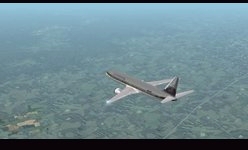 .home page .back Tutorials. Airliners
.home page .back Tutorials. Airliners
| Important! To Read! those tutorials about the night VFR and IFR ratings, and about flying the airliners are not as accurate and reliable than those dedicated to the VFR flights. It's because we really practised the VFR flights, as we didn't ever qualify for the night VFR and the IFR ratings nor any commercial license! Our tutorials about such flights are based on our VFR experience only, and augmented with data and readings taken from the Internet! People who would like to find in those the same level of accuracy and details than in our VFR tutorials, should better turn to further websites or source. People who are just looking for a honest level of realism might be satisfied already with the level of our tutorials about the night VFR, IFR flights, and the ones aboard an airliner |
Planning the descent from cruise is allowing do dissipate altitude and airspeed in order to arrive at a point before the instrument approach, for example, appropriately. Descending early will lead to more flight at low altitudes with increased fuel consumption as descending late will let you with some airspeed and altitude in excess on the approach. The point mostly used with a airliner, where you will begin your descent is called the 'Top of Descent' or TOD. The calculation to find where the TOD will be located on your route use too the concept of 'approach gate'. The approach gate is a not charted, imaginary point which the ATC will use to vector your plane to the instrument approach course. It may be located at 1 NM at least from the final approach fix (FAF) as described on the approach chart (the point whence you can begin your descent along the approach) as it is located no closer than 5NM from the runway threshold! The altitude of the approach gate point may be considered, with a good approximation, to be at about 1,000 ft above that of the chartered IAF (initial approach fix). The description herein may apply too to GA advanced airplanes, like a Beechcraft Baron 58, for example. The descent planning should not be overlooked and the descent be flewn stabilized, with the power properly set and minimum control input required. Planning the descent, on the other hand, will reduce your workload during those phases of flight which are busy times!
 a airliner shortly after TOD (non-clickable illustration) |
The TOD is computed like substracting the approach gate altitude from the cruise altitude and applying the target rate of descent and the descent groundspeed. That results into a time and distance for the TOD. In the real world, such a calculation is either done manually -in the case of a GA plane, for example- before the flight, or entered into the FMC of a airliner before takeoff. The real world aviators usually have at their disposal descent charts contained in the plane's operating handbook, which is true both for the GA advanced planes and the airliners, which give the time, distance, fuel needed for a descent from a given altitude at a given groundspeed
Like a example of a calculation of a TOD, should you fly a airliner at a cruise flight level of 320 (which is 32,000 ft of altitude) and aiming to reach a approach gate of 2,100 ft in altitude, with a descent rate of 1,800 ft/mn and descent groundspeed of 300 kts, compute your descent like:
You will note that the 250 kts speed restriction under the 10,000-foot mark has a minimal influence on the calcultion of the TOD only like has the effect of temperature or weight variation -like the ease on the weight of the plane during the descent due to the fuel being used- and therefore omitted. But don't forget too to include in the calculation what runway is in use as when it is the runway just opposed to your route heading which is in use, for example, that will mean added flight time to reach the instrument approach in that case. As in FS2002, planes don't have any descent chart, you will mostly have to consider the descent groundspeed being the one given in the plane's checklists or reference. Additionally, at last, should you have well samplified the fuel consumption of your plane, you should be able to take it in account like a factor in the descent, which is mostly needed before hand, during the preparation of the flight, to calculate accurately that part of the fuel consumption
The usual rule of thumb of the 3 to 1 formula as described often, and, for example, in the FS Help, is mostly used, in the real world, for initial descent planning. You will need, generally, 3 NM to descent 1,000 ft of altitude. That rule of thumb is meant for a jet airplane descending at idle thurst, at a speed of Mach 0.74 to 0.78 with a vertical speed of 1,800-2,200 ft per minute. A tailwind brings to a adjustment of adding 2NM for each 10 kts of wind; a headwind to substract 2NM for each 10 kts. Calculting a descent with that formula brings to some larger distance than like computed above: with a loss of altitude to be of 29,900 ft, 29.9 x 3 equals 89.7 NM, rounded off to 90 NM, instead of 85 NM. Of note that some advice to add 10NM more to the figure obtained, which there should bring to 100
Website Manager: G. Guichard, site Lessons In Microsoft Flight Simulator / Leçons de vol pour les Flight Simulator de Microsoft, http://flightlessons.6te.net.htm. Page Editor: G. Guichard. last edited: 3/31/2018. contact us at ggwebsites@outlook.com